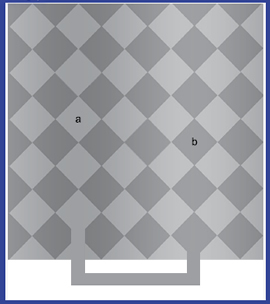
Contact Us
Jim Eaton
Publisher
519-538-1418
mailto:jeaton@primepublications.ca
Rose Marie Donovan
Editor in Chief
416-453-5965
mailto:donovan@mentalnotes.ca
Kirsten Donovan
Managing Editor
mailto:editorial@mentalnotes.ca
Mary Reid
416-752-0651
mailto:mreid@mentalnotes.ca
Mike Tam
Creative artist
Barry Lindsay
Graphic Designer
barrylindsay@msn.com
Prime Publications
85 Trowbridge Street West,
Meaford, Ontario, N4L 1G4, Canada
info@mentalnotes.ca
www.mentalnotes.ca
Checkerboard shading illusion The two diamonds a and b have the same luminance, or light intensity, yet look dramatically di erent in shade of grey (the diamonds in any vertical column all have the same luminance, so by following the connector between the diamonds at the bottom of the gure you can see that a and b are the same). The diamonds have the same luminance because a gradual luminance gradient has been added to the checkerboard, going from dark on the left to bright on the right. The result is that the addition of ‘dark-part-of-gradient’ plus ‘light-diamond’ on the left equals the addition of ‘bright-part-of-gradient’ plus ‘dark-diamond’ on the right. However the gradual luminance gradient is barely perceptible and our visual system treats it as illumination, speci cally shading. We tend to discard shading when estimating the color of surfaces, so we see the two diamonds as if the gradual luminance gradient were not there, i.e. as very di fferent shades of grey.

The illusion was designed by Professor Frederick Kingdom of the McGill Vision Research Unit, Department of Ophthalmology, McGill University. It is based on similar illusions designed by Professors Ted Adelson of the Massachusetts Institute of Technology and Alexander Logvinenko of Glasgow Caledonian University. Professor Kingdom has a longstanding interest in brightness illusions, as part of his on-going research on color vision funded by the Canadian Institute of Health Research.
| |
Published by Prime publications
